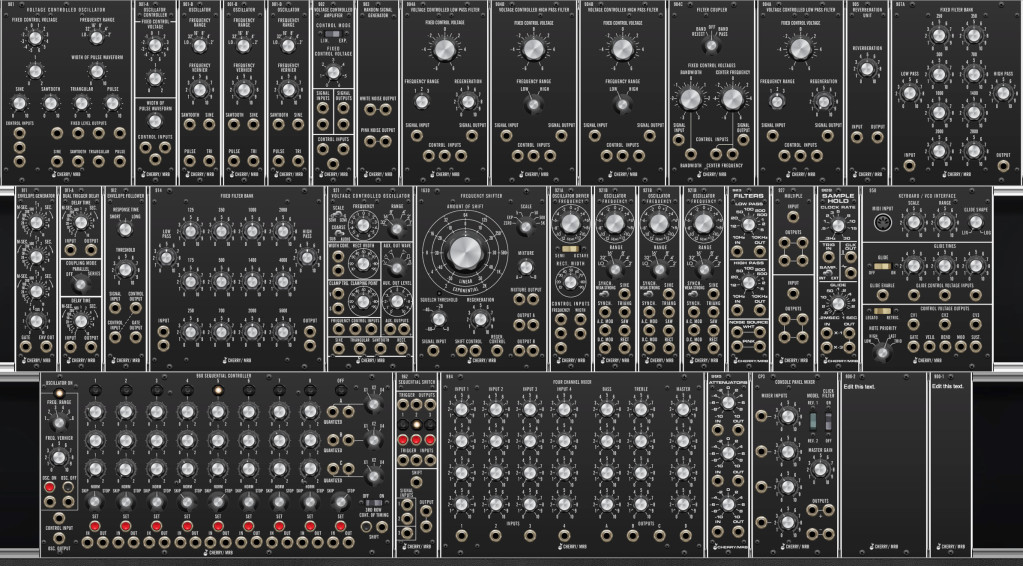It’s not so easy to get an authentic-sounding recreation of the classic 1960s Moog modular. So that makes Cherry Audio’s unofficial version welcome to all of us modular fans – and it’s just US$79.
Moog Music, for their part, have a very fine piece of software modeling in the Model 15. It’s based on what was originally conceived as an educational synth, and it fits nicely on the iPad (plus now runs on the Mac for when you want to record into your DAW easily). And that makes loads of sense. But to be clear, that is the 1973 Model 15 modular at its heart. And while there have been various recreations, we haven’t really gotten anything using this generation of software modeling and its ability to reproduce all the weird sonic idiosyncrasies of the original hardware.
Enter the VM900 Collection for Voltage Modular, from Cherry Audio. (You won’t see them use the Moog name, as the Moog company aren’t involved.) This really is a full 900 series, as you might assemble from the Moog catalog around 1965-1967. That 900 series is the catalog of modules Wendy Carlos used; a lot of these circuits were designed by Bob Moog himself. It was hand-built, very particular-sounding stuff.
I have a particularly personal connection to this, as I was lucky enough in college to have access to a well-maintained 900 series Moog (and 100-series Buchla), and haven’t really gotten to touch either since. (Hmm, side note – check residencies available!)
But I talked to Mitchell Sigman, designer over at Cherry, about what they’ve done, and there are some terrific details here.
The project grew out of a collaboration between Cherry Audio, Mark Barton, and MRB Labs – with Mark on DSP. Mark has his own notable history in synthesis, including designing the 1977 Syndrum and the very first speech synthesizer for the Mac. That’s right – if you remember the old Mac voice from the unveiling of Macintosh, that was Barton’s work, too, commissioned by Steve Jobs himself.
All of this Moog talk is a good excuse to get to learn about Mark Barton and his own, original modules for Voltage Modular. That is, while it’s definitely great to check out the 1960s Moog designs, you should branch out into new and original modules, too. Cherry posted details of Barton’s history:
Mark Barton, Modular Synthesis Pioneer, Founder of MRB Labs
But that makes this a fascinating collision – Cherry’s very nice software platform, one of the best-loved modular synths in history as source material, and one of the preeminent DSP engineers in electronic music history, all on one project. That also says there can be some healthy work on the Moog legacy even outside the current Moog company. (Seeing pictures of those Moog knobs is likely to increase, rather than decrease, your lusting after new Moog hardware kit, anyway.)

And it’s really the details here that make this appealing. They’ve nailed some of the subtle distortion on the mixer and VCAs – the things that make the actual 900 series a gritty joy, even as a lot of generic “east coast” recreations feel flat and vanilla. The oscillators drift a bit. Waveforms are emulated precisely, too, says Sigman.
That is, I’m all for original and new ideas in modules, but if I want a 900 sound, I really want the sound and function of the 900 modules – and that’s what they’ve done here. A quick play suggests they really did get it right.
You also get the 900-series workflow, with 960 Sequencer and 962 Sequential Switch. (The 960 also gives you an option of the original unquantized operation and more modern quantized – each per row. Correction: I misstated which were quantized/unquantized; this arrangement is perfectly logical.) Both 900 and 921 oscillators are there, too – I did also get access to these side by side and they sound different, so that’s welcome.
Probably the best part of this package, though, is the 1630 Bode Frequency Shifter. I think “east coast” synthesis gets an unfair reputation – well, partly because it isn’t really all that geographically correct (Moog being inland, Moog’s users being spread throughout the continent), but also in that it can be just as experimental as the Buchla approach. And sticking the 1630 in there really opens up those possibilities, which if you just had some oscillators and filters and a quantized sequencer you might (admittedly) miss. Plus there’s a Regeneration (feedback) knob, which is always a good thing.
And then this all runs inside Voltage Modular. That means you can mix and match with other stuff, which in the software modular realm is really the whole point. Want a dirty, warm 60s Moog oscillator mixed into your Low Pass Gate? A Bode Frequency Shifter working on some digital sources or waveshaping? Go for it. It also works with the free edition of Voltage Modular, so your US$79 goes a long way.
Good stuff. And yeah, Cherry are fast becoming the budget-friendly choice for models of a ton of stuff – in a market that’s already rich and high-quality for today’s software options. The quality of models industry-wide has just vastly improved in a few years, from a time when mostly what you got was fairly crude digital recreations leaning heavily on samples with only cosmetically accurate faceplates.
Wow, are we ever spoiled for choice – even on a tight (or no!) budget – on computer modulars. So don’t feel envy of people with massive hardware rigs; nothing should stop you from exploring sound.